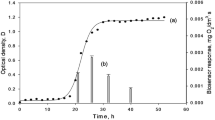Abstract
Amperometric biosensors for naphthalene were developed using either immobilized Sphingomonas sp. B1 or Pseudomonas fluorescens WW4 cells. The microorganisms were immobilized within a polyurethane-based hydrogel, which was used for a microbial biosensor for the first time. Both strains were shown to be equally suited for the quantification of naphthalene in aqueous solutions. The biosensors were tested in a flow-through system and a stirred cell (batch method). In both systems a linear response down to the detection limit was obtained. Measurements in the flow-through system gave sensitivities of up to 1.2 nA mg−1 l−1 and a linear range from 0.03 mg/l to 2.0 mg/l. The response time (t 95) was 2 min and the sample throughput six per hour; the repeatability was within ±5 %. With the batch method, sensitivities of between 3 nA mg−1 l−1 and 5 nA mg−1l−1 and a linear range of 0.01–3.0 mg/l were obtained; the response time was between 3 min and 5 min. The sensors reached an operational lifetime of up to 20 days. The sensitivity of both sensors for naphthalene was, in most cases, more than four times higher than for various other substrates.
Similar content being viewed by others
Author information
Authors and Affiliations
Additional information
Received: 18 October 1995/Received revision: 22 December 1995/Accepted: 22 January 1996
Rights and permissions
About this article
Cite this article
König, A., Zaborosch, C., Muscat, A. et al. Microbial sensors for naphthalene using Sphingomonas sp. B1 or Pseudomonas fluorescens WW4. Appl Microbiol Biotechnol 45, 844–850 (1996). https://doi.org/10.1007/s002530050772
Issue Date:
DOI: https://doi.org/10.1007/s002530050772




